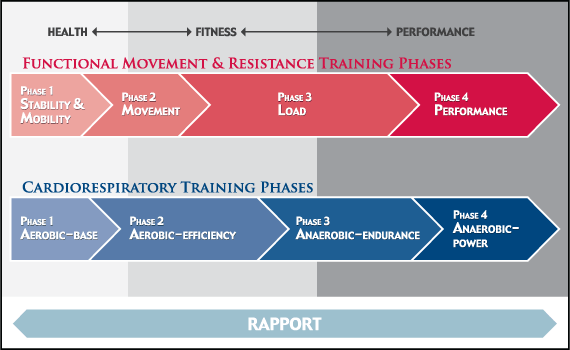The American Council on Exercise is proud to introduce the Fourth Edition of its ACE Personal Trainer Manual. This all-new textbook, which was written by a group of 14 industry experts, is designed to fill an important need in the fitness industry. In the past, many newcomers to personal training would read a textbook presenting fitness assessments, detailing resistance-, flexibility-, and cardiorespiratory-training programs, and providing motivational tools, and ask the same question: “Okay, so now what?” In other words, how does the reader assimilate all of this seemingly disparate information into a safe and effective training program for each of his or her clients?
The ACE Integrated Fitness Training™ Model (ACE IFT™) Model, which is a central feature of this new manual and is presented in Part III: The ACE Integrated Fitness Training Model (Chapters 5–12), was created to serve as a blueprint when meeting, assessing and training clients, from recently sedentary adults who are just getting started and seek improved overall health, to elite-level athletes working to enhance a specific aspect of their athletic performance. After introducing the various components of the ACE IFT Model, detailing the various assessments that personal trainers have at their disposal, and covering functional, resistance and cardiorespiratory training, this part of the textbook closes with Chapter 12: The ACE Integrated Fitness Training Model in Practice. This chapter offers six case studies that are representative of the types of clientele that personal trainers can expect to see over the course of their careers. Each case study presents the health history of the client, along with his or her goals, and then follows the client over the course of the program, offering progression templates, discussing obstacles and possible solutions along the way. This chapter is designed to help the reader synthesize the material presented in the previous seven chapters in a very practical sense. By combining the ACE IFT Model with appropriate leadership and implementation strategies as presented in Part II: Leadership and Implementation (Chapters 2–4), personal trainers can provide a truly individualized, integrated approach to achieving optimal health, fitness and performance.

Of course, to be successful as a personal trainer, there is other foundational information that individuals need to understand and be able to utilize. Chapter 1: Role and Scope of Practice for the Personal Trainer defines the personal trainer’s role within the healthcare continuum and details the scope of practice. In addition, this chapter discusses various avenues of career development for personal trainers.
Chapter 13: Mind-body Exercise explains how mind-body fitness, which includes everything from classical forms of yoga and tai chi to more contemporary options like the Alexander Technique and Nia, fits into the modern fitness industry.
Chapter 14: Training Special Populations presents essential information for working with individuals with various diseases and disorders once they have been cleared to exercise by their physicians. These two chapters comprise Part IV: Special Exercise Programming Topics.
Part V: Injury Prevention and First Aid is also composed of two chapters. Chapter 15: Common Musculoskeletal Injuries and Implications for Exercise begins by explaining common tissue injuries before presenting guidelines for managing these common injuries, including rotator cuff injuries, carpal tunnel syndrome, ankle sprains, and plantar fasciitis.
Chapter 16: Emergency Procedures discusses emergency policies and procedures for fitness facilities. Common emergencies ranging from choking and asthma to stroke and neck injuries are also discussed.
The final two chapters combine to form Part VI: Professional and Legal Responsibilities and Business Strategies. Chapter 17: Legal Guidelines and Professional Responsibilities addresses many of the standard legal and business concerns that personal trainers may have regarding business structure, employment status, contracts, insurance and risk management.
Chapter 18: Personal-training Business Fundamentals presents a topic new to ACE textbooks: How to thrive on the business side of your personal-training career. This chapter covers creating a brand, financial planning, choosing a business structure and effective marketing practices.
Our goal when putting together this textbook was to meet the needs of personal trainers at every stage of their careers, from deciding whether to work as an employee or independent contractor to owning one’s own fitness facility, from training people who walk in off the street to specializing in a niche clientele that allows you to increase your income and become a recognized expert in your community.